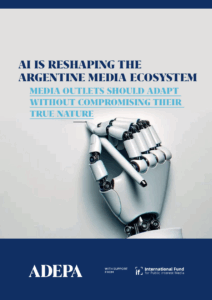Nearly a third of newsrooms in Argentina are using artificial intelligence (AI) tools to complete routine journalism tasks, according to a study published this month by the Association of Argentine Journalism Entities, known as Adepa.
 The report, based on 20 interviews with media professionals, found that 29% of participating outlets use AI to help write and edit articles, craft headlines and translate text. About 38% use it to transcribe interviews, and 40% rely on it to produce audio versions or summaries of articles, in some cases using a voice that imitates that of the author.
The report, based on 20 interviews with media professionals, found that 29% of participating outlets use AI to help write and edit articles, craft headlines and translate text. About 38% use it to transcribe interviews, and 40% rely on it to produce audio versions or summaries of articles, in some cases using a voice that imitates that of the author.
Most respondents, citing ethical and intellectual property concerns, rarely use AI image-generation tools, the study said.
The research team compared their findings with guidelines from organizations including The New York Times, The Guardian, O Globo, the Inter American Press Association and UNESCO.
“Argentine media outlets are at the forefront, at least in the region, when it comes to adopting and incorporating artificial intelligence tools into their work and news production process,” Agustina Ordoñez, one of the authors of the report, told LatAm Journalism Review (LJR).
Experiments to boost reporting and production
The newsrooms creating innovations include Clarín, Infobae, La Nación and Todo Jujuy, the report said.
Clarín developed UalterAI, a virtual assistant that summarizes articles and identifies key facts and figures. Infobae created ScribNews, designed for staff to automate parts of their fact gathering and production process. La Nación launched Voces, which generates audio versions of articles with a voice that imitates that of the reporter.
The fact-checking outlet Chequeado developed Desgrabador, a free transcription tool.
And the local outlet Todo Jujuy is using AI to automate articles about traffic, weather and sports.
“These are outlets that, both nationally and regionally, are introducing innovative tools,” Ordoñez said. They’re “adopting existing technologies to improve their workflows and the information production processes that ensure quality content.”
Recognition and fair compensation
According to the study, Argentina’s government does not regulate how AI platforms use content produced by news organizations. Nor have any Argentine outlets reached independent agreements with AI companies — a contrast to several major media organizations in the United States and Europe that have begun negotiating licensing deals.
Researchers warned this lack of regulation could make it harder for Argentine news organizations to monetize their work and could deepen the power imbalance between local media and global technology companies.
Andrés D’Alessandro, executive director of Adepa, told LJR that the group believes AI companies should acknowledge and compensate media outlets for their content.
“Both during the training of these tools and in their daily use, there must be a mechanism for recognition and fair payment,” he said.
Producing quality journalism, he added, “requires investment in reporters, in teams and in infrastructure. Therefore, if AI systems feed on that work, it’s only fair that there be financial compensation and transparency in how those materials are used.”
Standards that center humans
In the report, Adepa calls on Argentine news organizations to develop their own protocols for the use of AI in their newsrooms, which would function much like traditional style manuals.
The report emphasizes key principles including: ensuring human oversight in AI-assisted work, protecting intellectual property, maintaining transparency with audiences and promoting ongoing training for journalists.
The study also underscored that AI should serve to enhance, not replace, human capabilities.
"The main goal of AI is to increase human intelligence and improve people’s lives," it says. "Companies should develop and use AI so that the benefits exceed the foreseen risks. AI should be used to address real-world problems, drive economic progress and promote innovation across various fields."